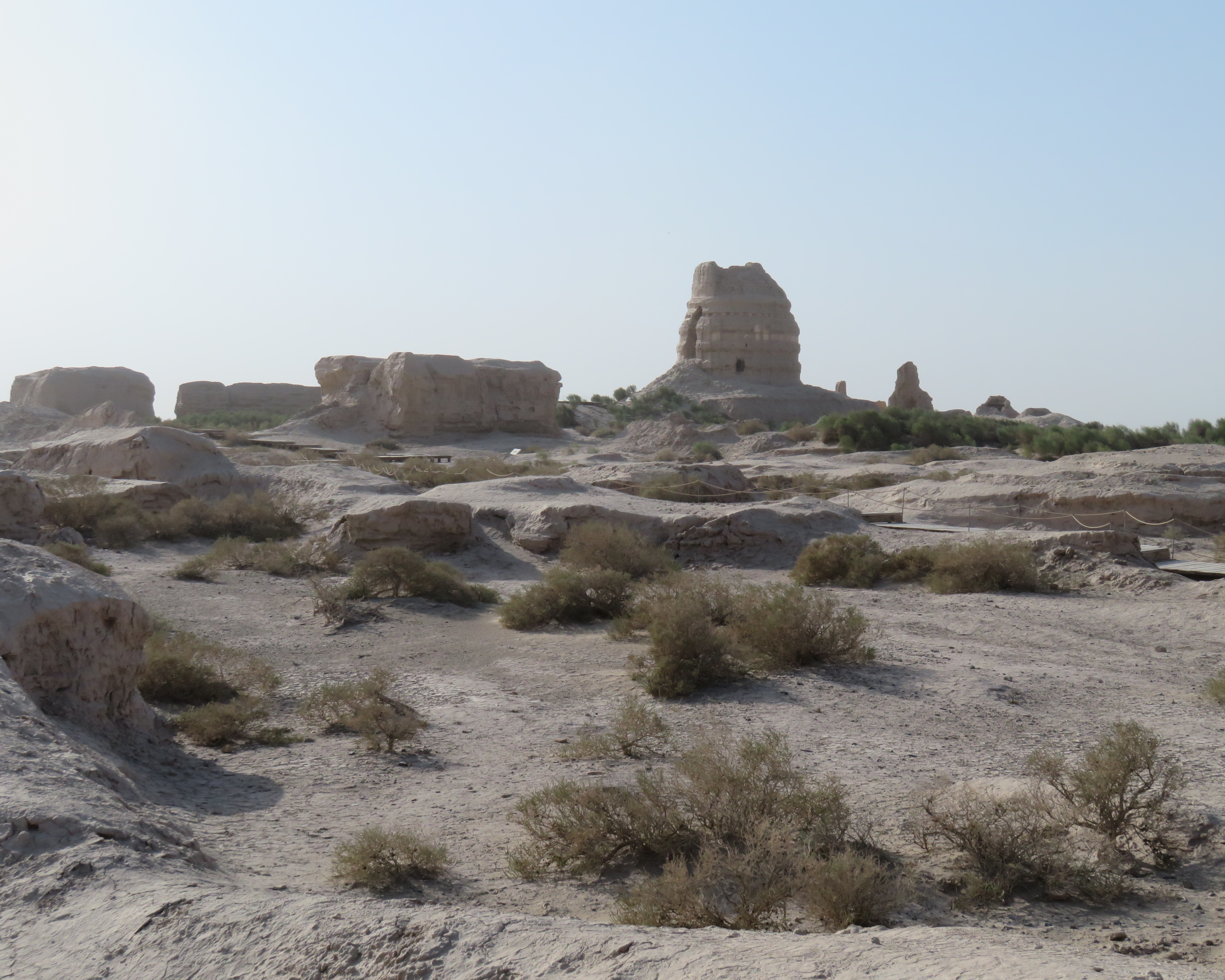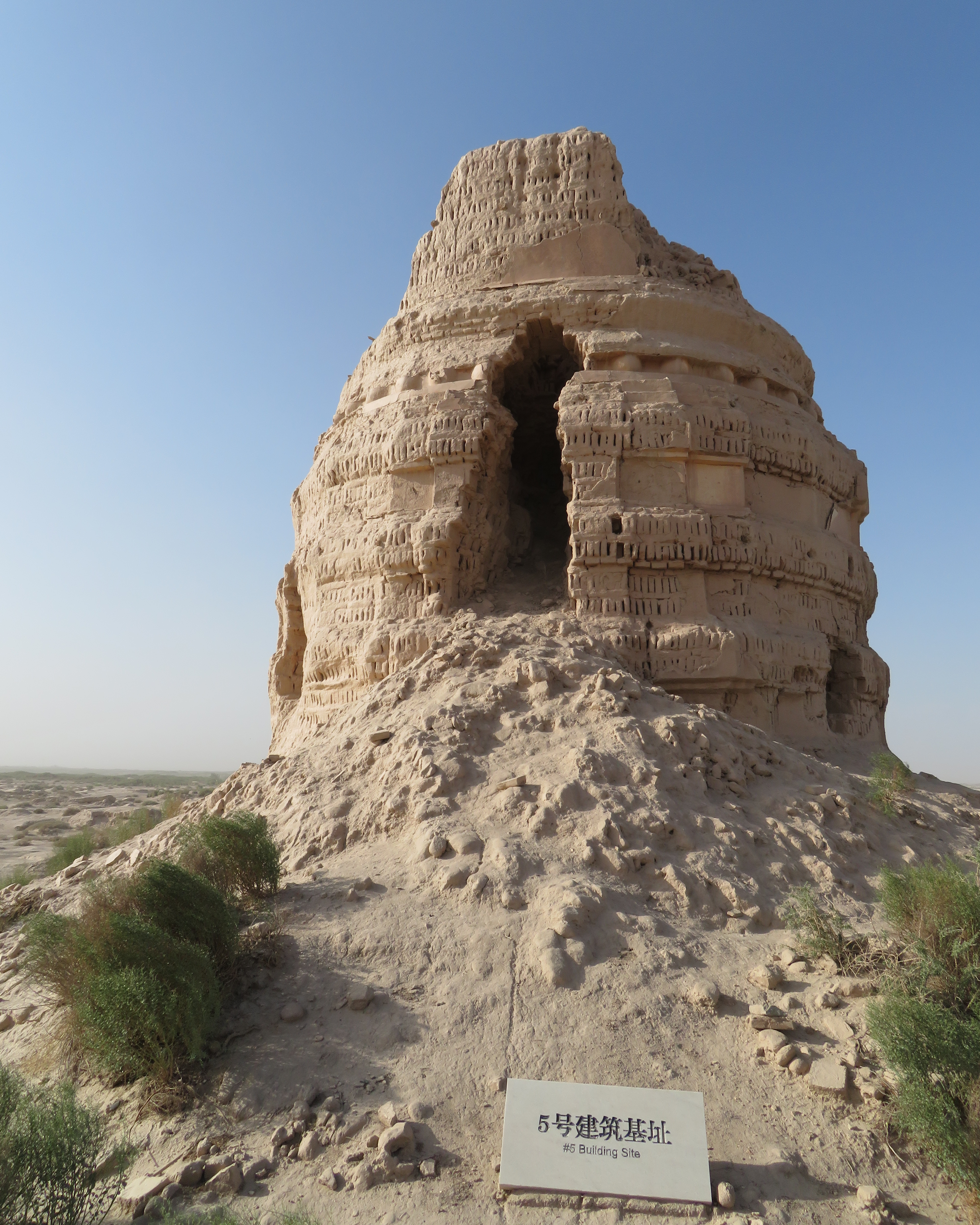Ta'er Temple (Suoyang City) on:
[Wikipedia]
[Google]
[Amazon]
 The Ta'er Temple () is the modern name of a ruined Buddhist temple outside of the walls of
The Ta'er Temple () is the modern name of a ruined Buddhist temple outside of the walls of
 The Ta'er Temple is located east of
The Ta'er Temple is located east of

 Scholar Li Zhengyu has identified the Ta'er Temple with the King Ashoka Temple recorded in historical documents. The King Ashoka Temple is described as being located east of Guazhou City, which matches Ta'er Temple's location. It was first built in the Northern Zhou dynasty at the latest, destroyed in Emperor Wu of Northern Zhou's suppression of Buddhism, and rebuilt in the Tang and Western Xia dynasties. In cave 16 of the Yulin Caves, a Western Xia monk named Huicong () from the King Ashoka Temple left inscriptions recording his pilgrimage to the cave temple with his disciples.
In 627, Tang dynasty monk Xuanzang preached in Guazhou for over a month before he set out for his famous pilgrimage to India, and the Ta'er Temple is thought to be the probable location of his sojourn.
The Qing dynasty publication ''New Gazetteer of Suzhou'' () records the discovery of a broken stone
Scholar Li Zhengyu has identified the Ta'er Temple with the King Ashoka Temple recorded in historical documents. The King Ashoka Temple is described as being located east of Guazhou City, which matches Ta'er Temple's location. It was first built in the Northern Zhou dynasty at the latest, destroyed in Emperor Wu of Northern Zhou's suppression of Buddhism, and rebuilt in the Tang and Western Xia dynasties. In cave 16 of the Yulin Caves, a Western Xia monk named Huicong () from the King Ashoka Temple left inscriptions recording his pilgrimage to the cave temple with his disciples.
In 627, Tang dynasty monk Xuanzang preached in Guazhou for over a month before he set out for his famous pilgrimage to India, and the Ta'er Temple is thought to be the probable location of his sojourn.
The Qing dynasty publication ''New Gazetteer of Suzhou'' () records the discovery of a broken stone
 The Ta'er Temple () is the modern name of a ruined Buddhist temple outside of the walls of
The Ta'er Temple () is the modern name of a ruined Buddhist temple outside of the walls of Suoyang City
Suoyang City (), also called Kuyu (), is a ruined Silk Road city in Guazhou County of Gansu Province in northwestern China. First established as Ming'an County in 111 BC by Emperor Wu of Han, the city was relocated and rebuilt at the curren ...
in Guazhou County
Guazhou County (), formerly (until 2006) Anxi County () or Ansichow, is a county in the northwest of Gansu province, the People's Republic of China. It is under the administration of Jiuquan City.
History
Emperor Wudi (140-87 BCE) had the ...
, Gansu
Gansu (, ; alternately romanized as Kansu) is a province in Northwest China. Its capital and largest city is Lanzhou, in the southeast part of the province.
The seventh-largest administrative district by area at , Gansu lies between the Tibet ...
, China. It has been tentatively identified with the King Ashoka Temple () recorded in historical documents, which was first built in the Northern Zhou dynasty (557–581) at the latest. The extant ruins, including the main adobe
Adobe ( ; ) is a building material made from earth and organic materials. is Spanish for ''mudbrick''. In some English-speaking regions of Spanish heritage, such as the Southwestern United States, the term is used to refer to any kind of e ...
pagoda and eleven smaller ones, mostly date to the Western Xia dynasty (1038–1227).
Temple ruins
 The Ta'er Temple is located east of
The Ta'er Temple is located east of Suoyang City
Suoyang City (), also called Kuyu (), is a ruined Silk Road city in Guazhou County of Gansu Province in northwestern China. First established as Ming'an County in 111 BC by Emperor Wu of Han, the city was relocated and rebuilt at the curren ...
, which was the seat of Guazhou Prefecture in the Tang dynasty. The temple ruins occupy an area of . The remaining structures include a main pagoda, 11 smaller ones, foundations of a drum tower and a bell tower, and residential quarters for monks.
At the center of the site lies the foundation of a large temple building, north of which is the main pagoda standing tall. The adobe
Adobe ( ; ) is a building material made from earth and organic materials. is Spanish for ''mudbrick''. In some English-speaking regions of Spanish heritage, such as the Southwestern United States, the term is used to refer to any kind of e ...
structure is covered by white lime and is of the shape of an overturned bowl. North of the main pagoda are the remains of 11 smaller ones. Most of the extant ruins date from the Western Xia dynasty, including all of the pagodas.
History and archaeology

 Scholar Li Zhengyu has identified the Ta'er Temple with the King Ashoka Temple recorded in historical documents. The King Ashoka Temple is described as being located east of Guazhou City, which matches Ta'er Temple's location. It was first built in the Northern Zhou dynasty at the latest, destroyed in Emperor Wu of Northern Zhou's suppression of Buddhism, and rebuilt in the Tang and Western Xia dynasties. In cave 16 of the Yulin Caves, a Western Xia monk named Huicong () from the King Ashoka Temple left inscriptions recording his pilgrimage to the cave temple with his disciples.
In 627, Tang dynasty monk Xuanzang preached in Guazhou for over a month before he set out for his famous pilgrimage to India, and the Ta'er Temple is thought to be the probable location of his sojourn.
The Qing dynasty publication ''New Gazetteer of Suzhou'' () records the discovery of a broken stone
Scholar Li Zhengyu has identified the Ta'er Temple with the King Ashoka Temple recorded in historical documents. The King Ashoka Temple is described as being located east of Guazhou City, which matches Ta'er Temple's location. It was first built in the Northern Zhou dynasty at the latest, destroyed in Emperor Wu of Northern Zhou's suppression of Buddhism, and rebuilt in the Tang and Western Xia dynasties. In cave 16 of the Yulin Caves, a Western Xia monk named Huicong () from the King Ashoka Temple left inscriptions recording his pilgrimage to the cave temple with his disciples.
In 627, Tang dynasty monk Xuanzang preached in Guazhou for over a month before he set out for his famous pilgrimage to India, and the Ta'er Temple is thought to be the probable location of his sojourn.
The Qing dynasty publication ''New Gazetteer of Suzhou'' () records the discovery of a broken stone stele
A stele ( ),Anglicized plural steles ( ); Greek plural stelai ( ), from Greek , ''stēlē''. The Greek plural is written , ''stēlai'', but this is only rarely encountered in English. or occasionally stela (plural ''stelas'' or ''stelæ''), whe ...
in the temple ruins. The remnants of the stele inscription, written in Tang dynasty calligraphy, lauded the 9th-century general Zhang Yichao, who recovered the Dunhuang
Dunhuang () is a county-level city in Northwestern Gansu Province, Western China. According to the 2010 Chinese census, the city has a population of 186,027, though 2019 estimates put the city's population at about 191,800. Dunhuang was a major ...
region after decades of Tibetan
Tibetan may mean:
* of, from, or related to Tibet
* Tibetan people, an ethnic group
* Tibetan language:
** Classical Tibetan, the classical language used also as a contemporary written standard
** Standard Tibetan, the most widely used spoken dial ...
control and was awarded high positions by the Tang court. The obverse side of the stele appeared to praise the deeds of Cao Yijin, a tenth-century governor of the Guiyi Circuit.
According to local eyewitnesses, a band of Russians came to the site in the 1940s and broke open the main pagoda. They found numerous sutras and paintings inside and took them away. Archaeologists later discovered a paper document from inside one of the smaller pagodas. On it are the printed words of the Buddhist mantra ''Om mani padme hum
' ( sa, ॐ मणि पद्मे हूँ, ) is the six-syllabled Sanskrit mantra particularly associated with the four-armed Shadakshari form of Avalokiteshvara, the bodhisattva of compassion. It first appeared in the Mahayana ''Kāraṇ ...
'', in the Tangut script of the Western Xia.
In 2014, Suoyang City and its associated ruins were inscribed on UNESCO's list of World Heritage Sites as part of Silk Roads: the Routes Network of Chang'an-Tianshan Corridor.
References
{{Reflist Western Xia architecture Buddhist temples in Gansu Ruins in China Tang dynasty Buddhist temples Guazhou County Northern Zhou